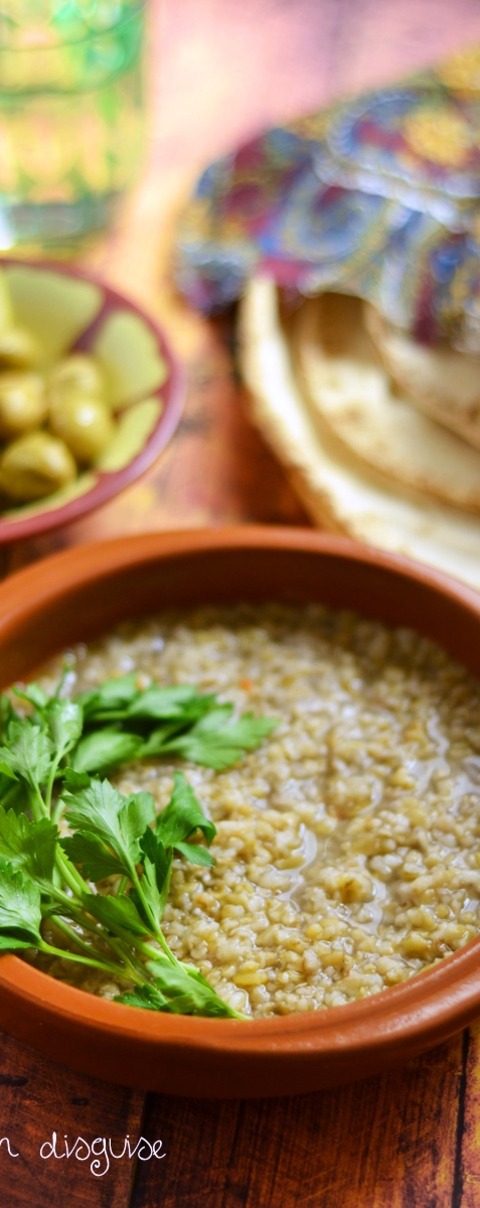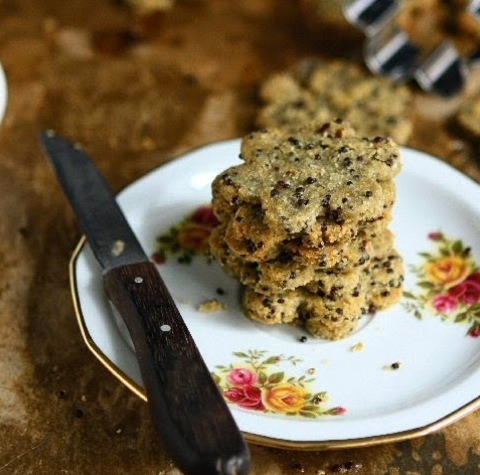#Freekeh
Explore tagged Tumblr posts
Text
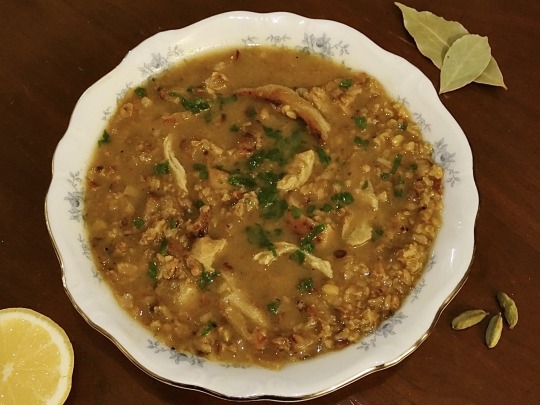

[ID: A greenish-brown soup with an herb garnish in a bowl surrounded by a halved lemon, green cardamom pods, and bay leaves, followed by a close-up of the same soup. End ID]
شوربة الفريكة / Shorabat al-frika (Green wheat soup)
Frika (فَرِيكَة or فَرِيك; also transliterated "freekeh," "frikeh," or "farik") is durum wheat harvested in the early spring, while the grain is green, unripe, and tender. Durum wheat, or semolina, is a different species of wheat than that which is ground to produce all-purpose flour (common wheat, or bread wheat); it is used to make couscous (كُسْكُس), bulghur (بلغور), and many types of pasta, and is widely consumed in North Africa, the Levant, and the Arabian peninsula. After harvest, unripe durum is sun-dried and then set ablaze in piles to burn off the straw and leave just the heads of wheat, resulting in a nutty, smoky flavor; the heads are then vigorously rubbed, traditionally by hand, to remove the bran. Frika is named after this last process; the word comes from the verb "فَرَكَ" "faraka," "to rub."
A staple in Palestine, shorabat al-frika (with diacritics, Levantine pronunciation: شُورَبَة الفْرِيكَة) is often eaten as an appetizer with the fast-breaking meal during Ramadan. It may contain nothing more than an onion, olive oil, frika, and water, but sometimes contains meat (usually chicken, but also beef or lamb), green chili peppers, and spices including cardamom, black pepper, bay leaves, turmeric, cumin, and seb'a baharat; some people today like to add chickpeas. Shorabat al-frika is often prepared with the chicken broth obtained by boiling chicken to make musakhkhan (مُسَخَّن), and served alongside it. It is a warming, filling, and earthy soup, with a complexity of flavor imparted by the frika itself: a fresh tartness due to the unripe grain, and a roasted aroma due to its harvesting process.
Shorabat al-frika is in keeping with a Palestinian food ethos of using simple, local ingredients to their fullest potential. Frika itself is sometimes thought to symbolize adaptability and resilience, as it was often eaten in times of scarcity when other crops were not yet ready to be harvested. Legend holds that it was discovered in a time of similar necessity: when villagers in the eastern Mediterannean tried to salvage a field of wheat that had been burned by ambushing soldiers, they found that the grain was still edible beneath the blackened chaff, having been saved from the fire by its moisture.
Frika, due to its centuries as a staple in Palestine, has also come to symbolize acceptance, Palestinian history, and connection to the land and community. In the Palestinian diaspora and amongst internally displaced people in Palestine, food is conceived of as a form of connection to homeland across distance; continuing to make Palestinian food, and remembering or using baladi ("native," "from my country") varieties of grains, produce, and herbs, is a link to the land and an expression of the hope to return.
By the same token, though, frika has come to represent Palestinian displacement and "cultural obliteration," per Rana Abdulla. One of the ways in which Israel rhetorically justifies its existence is by claiming sole ownership of an old, organically arising culture rooted in the land: the easiest way to do this is, of course, to rebrand what was already there. Food connects and combines language (in terminology and pronunciation), culture, history, climate, and land into one web of discourses, and is therefore a prime site for colonial myth-making and ideological nation-building. Thus a construction such as "Israeli freekeh" is, in fact, an intensely political one.
Nevertheless, frika continues its life as a symbol of connection, community, and resistance during adversity in Palestine. Nasser Abufarha, of the Palestine Fair Trade Association, noted in 2015 that more and more Palestinians across the West Bank were harvesting some of their wheat early to make frika, rather than relying on cheaper, imported rice. As of October 23 2023, and in defiance of an Israeli air raid which destroyed their kitchen in 2014, Jamil Abu Assi and his cousins were using frika, alongside lentils and rice, as staples in distributing food to thousands of refugees per day in Bani Suhaila, near Khan Younis. Others in the community donated ingredients or volunteered to distribute meals.
Support Palestinian resistance by contributing to Palestine Action's bail fund or to Palestine Legal's defence fund, or by attending court or making a sign to support the Elbit Eight.
Ingredients:
1 cup (170g) frika baladia (فريكة بلدية), Levantine frika
4 cups water, or vegetarian chicken stock from concentrate
1 large yellow onion, chopped
1/4 cup extra virgin olive oil
1 green chili pepper (ف��فل أخضر حار), sliced (optional)
1/2 tsp ground black pepper (فلفل اسود)
5 cardamom pods (حب هال)
2 Mediterannean bay leaves (ورق غار)
250g chicken (or beef) substitute, torn or cubed (optional)
Salt, to taste
Parsley, to garnish
Halved lemon, to serve (optional)
I have kept the spices relatively simple, as most cooks do, to highlight the earthy end of the taste spectrum and to allow the flavor of the frika itself to come forward. Most people add at least cardamom and black pepper; many add bay leaves to this duo; turmeric is the next most common addition I have come across. I have seen a few people add cumin, coriander, or allspice.
Frika can be found in the grains section of your local halal grocery store (labelled "فريكة", “فريك" "freekeh" or "frikeh"). Look for something that specifies “roasted.”
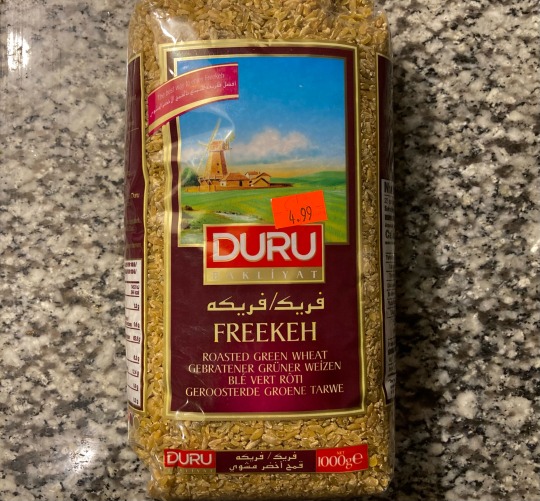
You may also be able to find frika at a speciality or health foods grocery store, but it might not have been fire-roasted as it is in the Levant. If your frika doesn't smell toasty, try roasting it in a dry pan on medium-heat for a few minutes until fragrant.
Frika may be found whole, cracked, or fine (نَاعِمَة / na'ima). You may use any kind for this soup; most people use cracked or fine frika, because of its shorter cooking time. You can pulse whole frika a few times in a food processor or spice mill, until coarsely ground, if you prefer a fine texture but can't find fine frika.
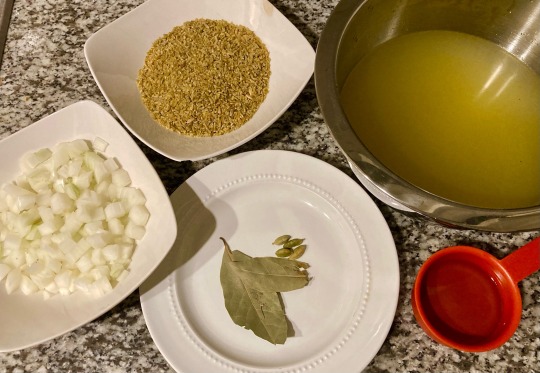
Instructions:
1. Heat olive oil in a large pot on medium. Add onion, a pinch of salt, cardamom pods, and bay leaves and fry, stirring occasionally, until the onion is golden brown.
2. Add the chili pepper and cook briefly until softened.
3. Add frika and black pepper and roast, stirring occasionally, for a few minutes until fragrant.
4. Add the water or stock and stir to combine. Bring to a fast simmer and cook, covered, about 50 minutes for whole frika and 20 minutes for ground, until fully cooked. Add additional water as necessary. The frika will still be chewy at the end of the cooking time.
5. Fry meat substitute of your choice in olive oil with salt, black pepper, and a optionally a pinch of Palestinian seven-spice, until browned. Add to soup and stir to combine. Taste the soup and add salt and more black pepper, if necessary.
6. Garnish with whole or chopped parsley and serve warm.
The meat is usually added to this soup just after the onions, and simmered along with the frika. You can do it this way if you like, but I have never found simmering to do the texture of meat substitutes any favors.
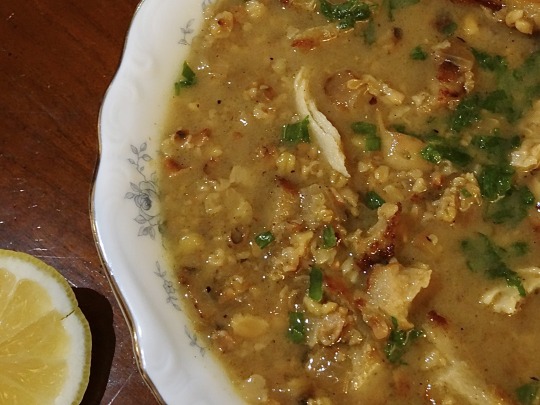
497 notes
·
View notes
Text
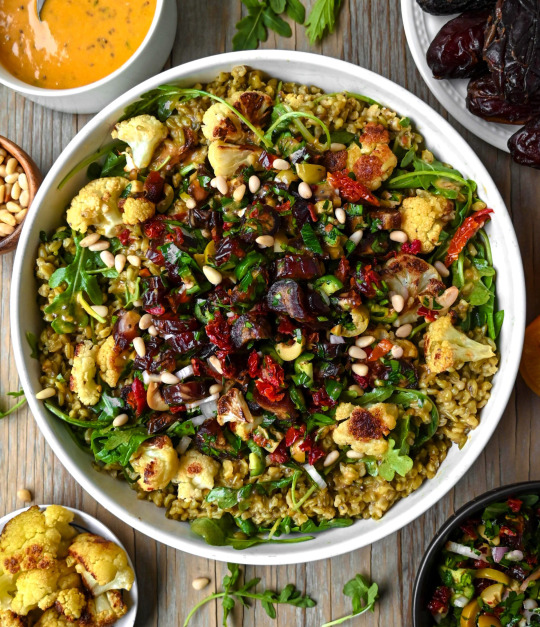
Vegan Freekeh Medjool Date Salad
#vegan#lunch#dinner#salad#pine nuts#freekeh#dates#arugula#cauliflower#sundried tomatoes#shallots#parsley#olives#serrano peppers#lime#thyme#chia seeds#preserved lemon#lemon#olive oil#maple syrup#black pepper#sea salt
39 notes
·
View notes
Text
hellooooo I was gifted some Palestinian freekeh by a friend but I have no idea how to eat it/cook it and everything I've read online is confusing me! anyway, if any of my Palestinian mutuals/followers have any tips on how to eat I'd be very grateful 🙏🏼 here's a photo of the packet my friend got me for reference!

10 notes
·
View notes
Text

When served with wilted spinach and freekeh, this salmon dish with a pistachio crust is reminiscent of bistro fare.
0 notes
Text

Use your Instant Pot to make this creamy vegetable soup with freekeh, an ancient grain, plus carrots, mushrooms, and celery.
0 notes
Text
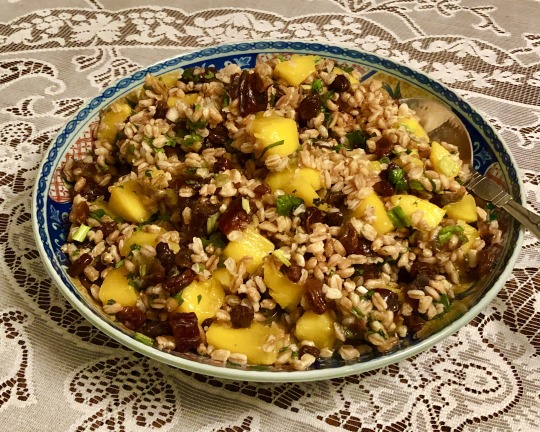
I use whole grains a lot! For soup and casseroles and also salads. I can't even say "they're a nice change from rice and pasta," because in my house we eat them as often as rice or pasta.
Farro, freekeh, barley and so on, are easy to make, filling enough for a main course, useful as a side dish, mild enough to be incredibly versatile and just plain delicious.
See for yourself with this pretty salad!
Follow me on Instagram @ronnievfein
WHOLEGRAIN SALAD WITH DATES, NUTS AND MANGO
1 cup wholegrain such as freekeh, farro, brown rice, oat groats, barley
8 medjool dates, chopped
1 cup thawed, frozen peas, cubed tofu or leftover chicken
3/4 cup chopped nuts (almonds, cashews, pistachios)
1/2 cup raisins
1 ripe mango, peeled and diced (or use peach, nectarine or halved grapes)
4 chopped scallions
1/4 cup chopped fresh parsley
2 tablespoons chopped fresh mint
6 tablespoons extra virgin olive oil
3 tablespoons white wine vinegar
3 tablespoon mango juice or orange juice
2 tablespoons lemon juice
Salt and freshly ground black pepper to taste
Cook the grain according to package directions until the grains are tender but still somewhat firm and all the liquid has been absorbed. Remove from the heat and set aside to cool. Place the cooked grain in a bowl. Add the dates, peas, nuts, raisins, mango, scallions, parsley and mint. Toss ingredients gently to distribute them evenly. Combine the olive oil, white wine vinegar, mango/orange juice and lemon juice and whisk vigorously. Pour the dressing over the salad. Toss the salad and season to taste with salt and pepper. Let rest for about 10-15 minutes before serving.
Makes 6-8 servings
#whole grains#farro#freekeh#farro salad#freekeh salad#whole grain salad#whole grain salad with dates#whole grain salad with mango
0 notes
Text
Chorba Frik


Czy wraz z nadejściem chłodniejszych dni i nominalnej jesieni przeprosiliście się już z Panią Zupą? A może wcale się z nią nie rozstawaliście, bo przywiązanie do gorącej przyjaciółki było silniejsze niż upały na dworze?
Ja w chłodne dni ogrzewam się od środka treściwymi, ciepłymi posiłkami, a do nich zalicza się między innymi chorba (aka shorba, shorwa, ciorbă).
Myślałam, że przepis na tę potrawę jest względnie jednolity: gęsta, warzywno-mięsna, z przewagą pomidorów. Sugerował to południowoeuropejski - jak mi się pierwotnie wydawało - rodowód. Byłam jednak w błędzie. Metryka narodzenia chorby to region Lewantu. Występuje w kuchniach narodowych na Bliskim Wschodzie, w Maghrebie, Azji Środkowej i Południowej, Afryce Północnej i Wschodniej, a także w Europie Południowo-Wschodniej. Nic dziwnego, że przepisów na nią jest cała masa! Nie wiem nawet czy są jakieś punkty wspólne, bowiem trafiłam na wersje czyste jak bulion, czy też bezmięsne.
I tak afgańska shorwa zbudowana jest z jagnięciny, ziemniaków, pomidorów i rzepy; algierska chorba z jagnięciny, pomidorów, ciecierzycy i freekeh; mołdawska i rumuńska ciorbă składa się z różnych warzyw, mięsa drobiowego, zakwasu owsianego i makaronu vermicelli; bułgarska oprócz podstawowych warzyw zawiera również białą fasolę itd.
Zatem chorba to po prostu szeroka klasa bogatych zup, zarówno mięsnych, jak i wegetariańskich, z charakterystycznym zestawem przypraw.
Algierska (a także tunezyjska) wersja nazywa się chorba frik i wykonana jest z jagnięciny, pomidorów, ciecierzycy i freekeh. Arabskiego aromatu i kolorytu dodają jej: ciepły cynamon, kurkuma, kumin, mieszanka ras el-hanout (żółta, z przewagą kurkumy lub czerwona, z przewagą papryki) oraz chłodna mięta i kolendra. Może do niej trafić jagnięcina krojona w kostkę, ale także w formie pulpecików. Niektórzy używają kurczaka. Często podaje się ją z pieczywem, np. borek.
Freekeh - inaczej frik lub farik - to rodzaj pszenicy durum zbieranej, gdy jest jeszcze zielona, a następnie układanej w stosy i suszonej na słońcu. Stosy są ostrożnie podpalane, tak aby spaliła się tylko słoma i plewy. Wysoka zawartość wilgoci w nasionach zapobiega ich zniszczeniu. Następnie prażoną pszenicę młóci się i suszy na słońcu w celu uzyskania jednolitego smaku, tekstury i koloru. I to właśnie proces tarcia ziaren dał im nazwę farīk (tarty). Na koniec nasiona są rozłupywane na mniejsze kawałki, które przypominają zielony bulgur. Freekeh ma lekko wędzony smak. Stosowany jest szeroko do zagęszczania zup, rozmaitych pilawów i innych dań w wielu krajach wschodniego basenu Morza Śródziemnego od stuleci.
Wspomnienie tego zboża pojawia się już w Tanach (tzw. Biblia hebrajska, która została przyjęta przez chrześcijan i stanowi - z pewnymi zmianami - Stary Testament). Freekeh jest tam wymieniony pod terminem qalûy (biblijny hebrajski: קָל֤וּי, co znaczy przypalany lub pieczony) lub karmel (biblijny hebrajski: כַּרְמֶל), co wskazuje, że był używany w starożytnej kuchni izraelskiej. W II Księdze Królewskiej prorok Elizeusz cudownie nakarmił około stu mężczyzn chlebem jęczmiennym i karmelem. Syryjska wersja Tanach tłumaczy ten termin jako froka, pokrewny arabskiemu freekeh (językoznawcy Biblijni niech mnie poprawią, jeśli coś namieszałam - uwielbiam ich wnikliwe analizy!).
Chorba Frik jest powszechnie spożywana w Algierii w miesiącach zimowych, a zwłaszcza w czasie ramadanu, jako element iftar - pierwszego posiłku jedzonego przez muzułmanów po zachodzie słońca.
Ja, katoliczka, też ją lubię.
Składniki:
2/3 szklanki freekeh 500 g łopatki jagnięcej cebula 2-3 ząbki czosnku łyżeczka słodkiej papryki 1/2 łyżeczki pieprzu cayenne łyżeczka cynamonu łyżeczka kurkumy łyżeczka suszonej kolendry łyżka suszonej mięty łodyga selera naciowego szklanka gotowanej ciecierzycy 2 małe marchewki 2 łyżki koncentratu pomidorowego 4 dojrzałe pomidory sól i czarny pieprz do smaku kilka gałązek świeżej kolendry (u mnie nać pietruszki) cząstki cytryny do serwowania
Wykonanie:
Mięso opłukać, osuszyć papierem kuchennym i pokroić w dużą, ok. 2 cm kostkę. Cebulę obrać i pokroić w kosteczkę. Czosnek obrać, zmiażdżyć płaską stroną noża i maksymalnie rozdrobnić. Seler pokroić na plasterki. Marchew obrać i pokroić w półplasterki. Pomidory pozbawić twardego rdzenia i pokroić w dużą kostkę. Ciecierzycę odsączyć z zalewy.
Freekeh wypłukać w zimnej wodzie i usunąć wszelkie ciemne kawałki, które mogą nie być ziarnami. Odcedzić na gęstym sicie i odstawić.
W garnku o grubym dnie rozgrzać chlust oleju rzepakowego. Wrzucić mięso i dobrze obsmażyć. Dodać cebulę, czosnek, seler i przyprawy (w Algierii bardzo często stosowana jest mieszanka nawet 30 przypraw, ras el-hanout). Jeśli trzeba, podlać odrobiną oleju. Smażyć na mrugającym ogniu ok. 10-15 minut, mieszając od czasu do czasu.
Dodać pomidory, koncentrat pomidorowy, ciecierzycę, marchew i zalać taką ilością wody, by przykryła z lekką nadwyżką zawartość garnka. Przykryć pokrywką i gotować aż warzywa stracą twardość.
Dodać do zupy freekeh. Gotować na wolnym ogniu, aż ziarna staną się miękkie, ok. 15 minut. Dosmakować solą i pieprzem.
Podawać z porcją siekanej kolendry. U mnie na zdjęciu wystąpiła nać pietruszki, bo w sklepie akurat kolendry nie było.
Przed jedzeniem skropić sokiem z cytryny.
#chorba frik#chorba#shorba#zupy#soups#kuchnia algierska#algerian cuisine#jagnięcina#lamb#freekeh#frik#ciecierzyca#chickpea#autumn recipes#fall recipes#kuchnia lewantu#kuchnia lewantyńska#levant cuisine
1 note
·
View note
Photo
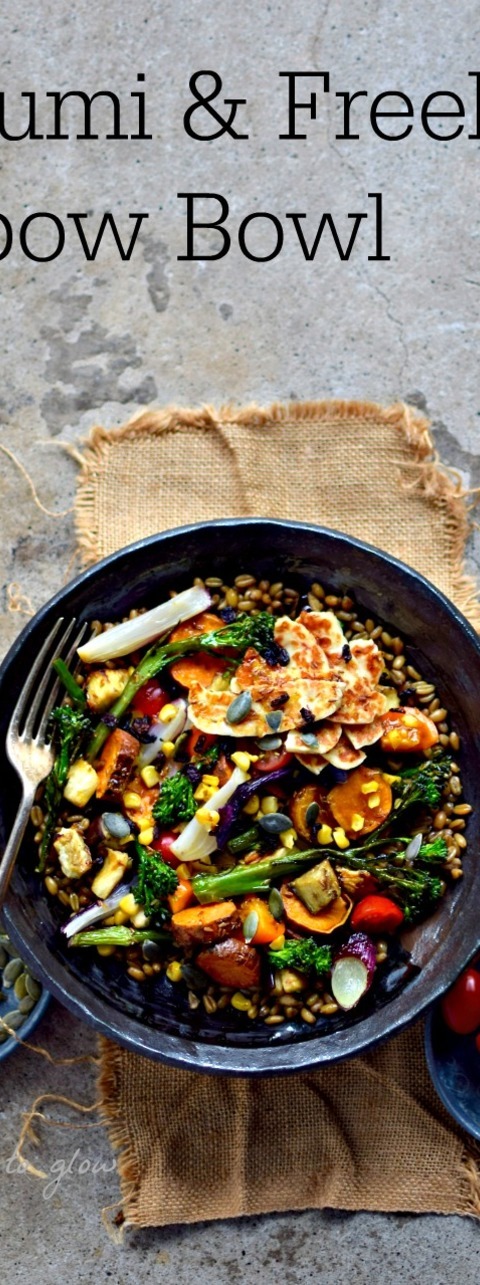
Halloumi and Freekeh Roasted Rainbow Bowl
0 notes
Text

Rustic Wild Sorrel Salad with Fresh Mint and Thyme (Vegan)
#vegan#appetizer#salad#sorrel greens#tomatoes#shallots#mint#thyme#pomegranate molasses#olive oil#sea salt#freekeh#💚
9 notes
·
View notes

